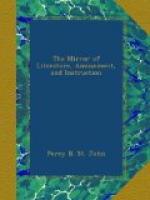THE MIRROR OF LITERATURE, AMUSEMENT, AND INSTRUCTION.
Vol. 10, No. 287.] Saturday, December 15, 1827. [Price 2d.
* * * * *
[Illustration: New steam carriage.]
Explanation of the References.
1. The Guide and Engineer, to whom the whole management of the machinery and conduct of the carriage is intrusted. Besides this man, a guard will be employed.
2. The handle which guides the Pole and Pilot Wheels.
3. The Pilot Wheels.
4. The Pole.
5. The Fore Boot, for luggage.
6. The “Throttle Valve” of the main steam-pipe, which, by means of the handle, is opened or closed at pleasure, the power of the steam and the progress of the carriage being thereby regulated from 1 to 10 or 20 miles per hour.
7. The Tank for Water, running from end to end, and the full breadth of the carriage; it will contain 60 gallons of water.
8. The Carriage, capable of holding six inside-passengers.
9. Outside Passengers, of which the present carriage will carry 15.
10. The Hind Boot, containing the Boiler and Furnace. The Boiler is incased with sheet-iron, and between the pipes the coke and charcoal are put, the front being closed in the ordinary way with an iron door. The pipes extend from the cylindrical reservoir of water at the bottom to the cylindrical chamber for steam at the top, forming a succession of lines something like a horse-shoe, turned edgeways. The steam enters the “separators” through large pipes, which are observable on the Plan, and is thence conducted to its proper destination.
11. “Separators,” in which the steam is separated from the water, the water descending and returning to the boiler, while the steam ascends, and is forced into the steam-pipes or main arteries of the machine.
12. The Pump, by which the water is pumped from the tank, by means of a flexible hose, to the reservoir, communicating with the boiler.
13. The Main Steam Pipe, descending from the “separators,” and proceeding in a direct line under the body of the coach to the “throttle valve” (No. 6,) and thence, under the tank, to the cylinders from which the pistons work.
14. Flues of the Furnace, from which there is no smoke, coke and charcoal being used.
15. The Perches, of which there are three, conjoined, to support the machinery.
16. The Cylinders. There is one between each perch.
17. Valve Motion, admitting steam alternately to each side of the pistons.
18. Cranks, operating on the axle: at the ends of the axle are crotches (No. 21,) which, as the axle turns round, catch projecting pieces of iron on the boxes of the wheels, and give them the rotatory motion. The hind wheels only are thus operated upon.




